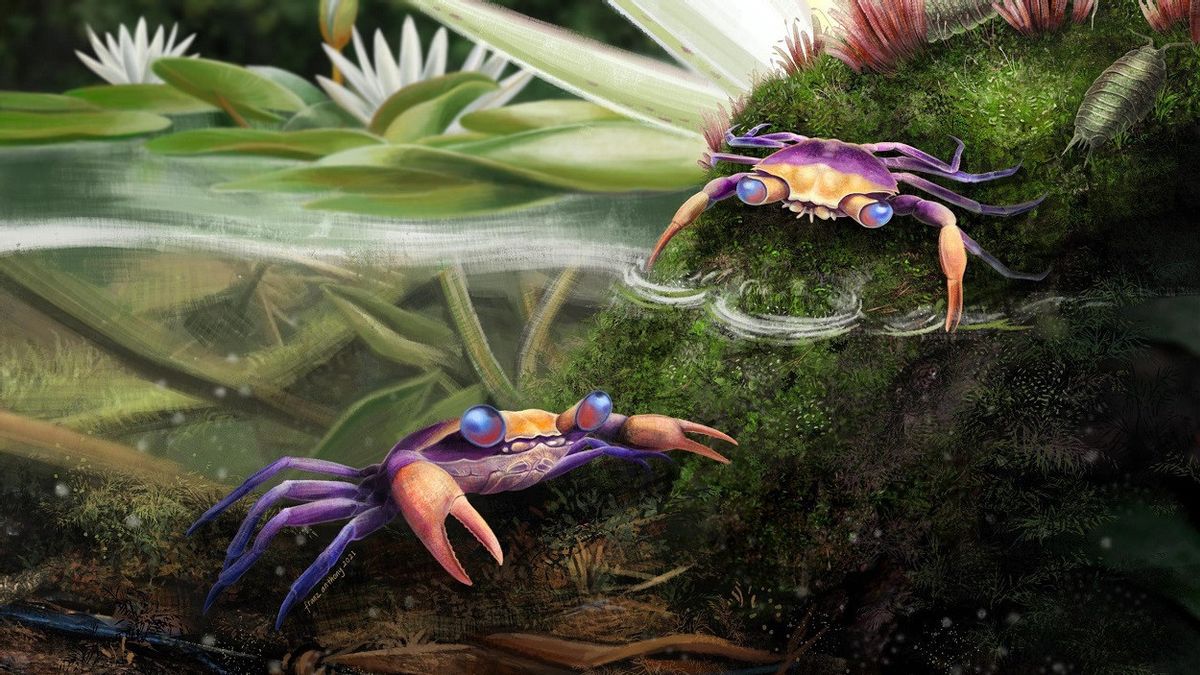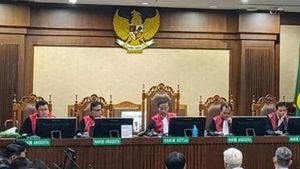JAKARTA - Fossils trapped in amber provide a unique picture of the anatomy, biology, and ecology of extinct organisms. The most common fossils found in amber, which is formed from resin that comes out of tree bark, are land animals, especially insects. But on a very rare occasion, scientists find amber that harbors aquatic organisms.
In a study published on October 20, 2021, in the journal '', an international team of researchers described the first crabs from the Cretaceous dinosaur era preserved in amber.
This study used microCT to examine and describe Cretapsara athanata, the oldest modern-looking crab (around 100 million years old) and the most complete crab fossil ever found.
It is rivaled in completeness by the mysterious Callichimaera perplexa, a very distant relative dubbed the platypus of the crab world. Callichimaera's amazing preservation includes soft tissues and delicate parts that are rarely fossilized.
Both Cretapsara and Callichimaera are new branches on the crab tree of life that lived during the Cretaceous Crab Revolution, a period when crabs diversified around the world and the first modern groups originated while many others disappeared.
True crabs, or Brachyura, are an iconic group of crustaceans whose incredible diversity of form, species richness and economic importance have inspired celebrations and festivals around the world. They even get a special role in the ranks of social media. True crabs are found all over the world, from the depths of the oceans, to coral reefs, beaches, rivers, caves and even in trees because true crabs are one of the few groups of animals that have conquered land and fresh water time and time again.
The crab fossil record extends back to the early Jurassic, more than 200 million years ago. Unfortunately, fossils of non-marine crabs are rare and are mostly confined to pieces of the animal's carapace, claws and feet found in sedimentary rocks. That is until now with the discovery of Cretapsara athanata.
"The specimen is spectacular, it's one of a kind. It's completely complete and not a single hair is missing on the body, which is amazing," said lead author Javier Luque, a postdoctoral researcher in the Department of Organismal Biology and Evolution, Harvard University, quotes Sci Tech Daily October 24.

A group of scientists led by co-lead author Lida Xing of the China University of Geosciences, Beijing, made a micro-CT scan of the fossil, which is kept at the Longyin Amber Museum in Yunnan, China. The scans created a full three-dimensional reconstruction of the exquisite animal preservation that allowed Luque, Xing, and their team to see the entire animal's body including delicate tissues, such as the antennae and mouthparts lined with fine hair. Surprisingly they found the animal also had gills.
"The more we studied the fossils, the more we realized that these animals were very special in many ways," Luque said. Cretapsara looks very modern – superficially resembling some of the beach crabs found today – unlike most crabs during the Middle Cretaceous which look very different from modern crabs. However, the animal was buried in Cretaceous yellow and the presence of well-developed gills indicates an aquatic to semi-aquatic animal. Aquatic animals are rarely preserved in tree resin which turns yellow.
The crabs previously found in amber were only a handful and belonged to the tropical land-living group and the tree-living crabs known as the Sesarmidae of the Miocene (15 million years ago). So how, the researchers ask, did 100-million-year-old aquatic animals become preserved in amber trees, which normally house land-dwelling specimens?
The gills allow aquatic animals to breathe underwater. Yet crabs have successfully and independently conquered land, brackish water, and freshwater at least twelve times since the time of the dinosaurs. Thus their gills evolved to include lung-like tissue that allows them to breathe both in and out of water. However Cretapsara lacked lung tissue, only well-developed gills indicating that the animal was not completely land-dwelling.
"Now we are dealing with an animal that is probably not marine, but also not completely terrestrial. In the fossil record, non-marine crabs evolved 50 million years ago, but these animals have doubled in age," Luque said.
The team's phylogenetic studies show that carcinization (the evolution of the crab-like appearance) actually occurred in the most recent common ancestor of all modern crabs more than 100 million years ago. Cretapsara bridges the gap in the fossil record and asserts that crabs actually invaded land and freshwater during the dinosaur era, not during the mammalian era, pushing the evolution of non-marine crabs further back in time.
The researchers hypothesized that Cretapsara, measuring five millimeters across a leg span, was a juvenile crab from a freshwater to amphibian species. Alternatively, the animal may be a semi-terrestrial juvenile crab that migrates ashore from the water as was the case with the iconic Christmas Island red crab in which the mother land crab releases its young into the sea, which then swarm out of the water back onto land.
They further hypothesized that, like the crabs found in amber from the Miocene, Cretapsara could have been tree climbers. "These Miocene crabs were truly modern-looking crabs and, as their extant relatives, they lived in the trees in small pools of water. These arboreal crabs can be trapped in tree sap today, but does that explain why Cretapsara was preserved? in yellow?" Luque explained.
The study is part of a National Science Foundation-funded project involving Luque, Professor Javier Ortega-Hernández and postdoctoral researcher Joanna Wolfe, both in the Department of Organism Biology and Evolution, Harvard University, and Professor Heather Bracken-Grissom of Florida International University.
The researchers chose the names Cretapsara athanata, which means the eternal Cretaceous spirit of cloud and water, in honor of the Cretaceous, where these crabs live, and Apsara, the spirit of cloud and water in South and Southeast Asian mythology. The species name is based on 'athanatos', immortal, referring to its preservation which lives as if 'frozen in time' in a yellow time capsule.
The English, Chinese, Japanese, Arabic, and French versions are automatically generated by the AI. So there may still be inaccuracies in translating, please always see Indonesian as our main language. (system supported by DigitalSiber.id)













